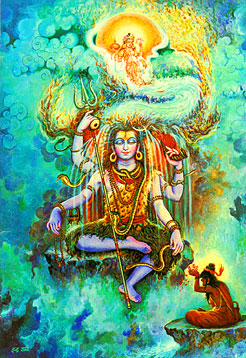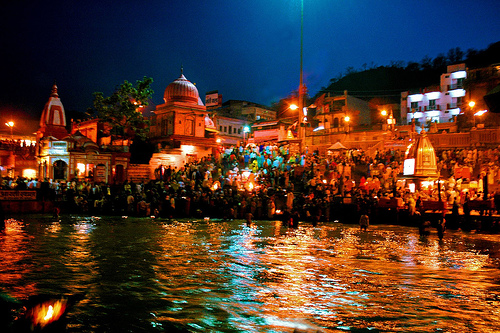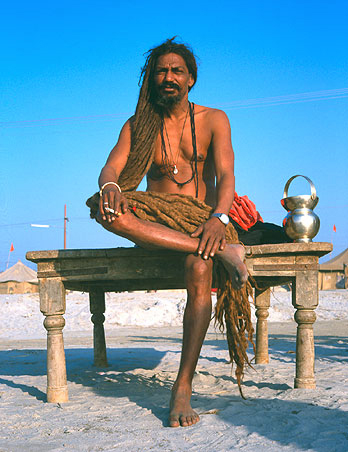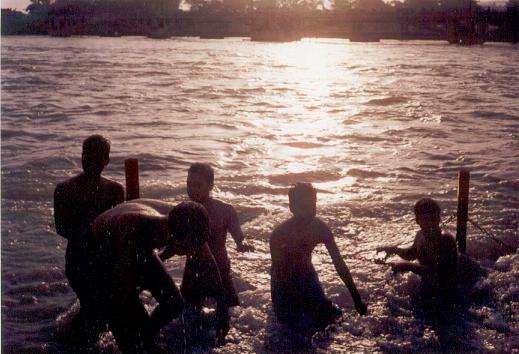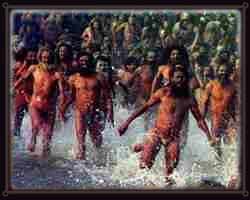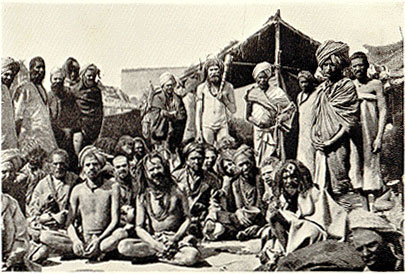| Section 3 : Ganga in Hindu
myth
|
||
| SECTION 1
SECTION 2 SECTION 3 SECTION 4 SECTION 5 SECTION 6 SECTION 7 SECTION 8 SECTION 9 SECTION 10 SECTION 11 |
  
Ganga in hindu myth
The Ganga has an exalted position in the Hindu ethos. It is repeatedly invoked in the Vedas, the Puranas, and the two Indian epics, the Ramayana and the Mahabharata. Ganga is a goddess, Ganga devi, one of two daughters of Meru (the Himalayas), the other being Uma, consort of Shiva. In her youth, Indra had asked for Ganga to be given to heaven to soothe the Gods with its cool waters. The story of its descent to earth appears in slightly different forms in Ramayana (Bala Kanda: Vishwamitra narrates it to the child Rama), Mahabharata (Aranya Parba: Agastya narrates it to Rama), and in the Puranas. These myths are variously dated between 2000 to 400 BC (you may be interested in this over-detailed dateline for Rama's life). The general outline of the story is: The king Sagara had two wives. By a favour of the lord Shiva, one wife bore him sixty thousand sons, all of whom were to die simultaneously, and the other bore him one son, Asamanjas, who would continue the dynasty. The sixty thousand sons grew to be great warriors, while the mighty Asamanjas caused so much misery to the populace that his father the king had to expel his own son, though a grandson, Ansuman, was left behind. King Sagara once performed the horse ceremony, in which a horse is allowed to roam at will, and is followed by warriors. Stopping the horse is a challenge to war; not stopping it is a compact of obeisance. In this instance, the sixty thousand sons were following the horse, but surprisingly, the horse was lost. After much recrimination, they dug up the entire earth and the underworld, the oceans, searching for the horse. Eventually it was found in a deep cavern, loitering close to where the sage Kapila sat in radiant meditation. The sons gathered the horse but they disturbed the great Kapila (Vasudeva), who was very annoyed, and instantly burnt them to ash with his fiery gaze.
Sagara heard of this fate through Narada, the heavenly wanderer, and sent the grandson Ansuman to undo the harm. Ansuman descended to the underworld and met Kapila, who was much pleased with the youth's bearing and conversation. He granted that the soulse of the sons of Sagara may be released by the waters of Ganga, then resident in heaven. Despite much austerity and prayer, neither Sagara, nor Ansuman after him, nor his son Dilipa, could get Ganga to appear on earth. Finally it was Dilipa's son Bhagiratha, who after severe austerities, propitiated the Goddess, and she agreed to come down to earth. However, the impact of her fall would be so severe, that it could be borne by none less than Shiva himself. Therefore Bhagiratha went into meditation again and obtained Shiva's consent after many more austerities. Finally, the river came down and fell into Shiva's matted hair, and thence to earth. This is the presumed site of the present-day temple at Gangotri. Bhagiratha led the way on horse back and the river followed. In this manner they reached the spot where lay the ashes of the six thousand sons. They were thus liberated, and an ocean formed from the waters there. This is the Sagar Island of today, where the Ganges flows into the Bay of Bengal ("Sagara' is also Sanskrit for ocean).
Many other tales are associated with the Ganga and points on it. Hari (Lord Vishnu) himself bathed in its waters at Haridwar, which is so holy that sins as great as the murder of Brahmins may be washed away by bathing here. Hindus to this day use the water of the Ganga to cleanse any place or object for ritual purposes. Bathing in the Ganga is still the lifelong ambition of many of India's believing masses, and they will congregate on its banks for the tremendously overcrowded Sangam, Sagar Mela or Kumbh Mela which are held on auspicious dates every few years.
The Ganges has many names associated with its many roles in Sanskrit mythology. Bhagiratha himelf is the source of the name Bhagirathi (of Bhagiratha), which is its initial stream, but is also another name for the Hooghly. At one point, Bhagiratha went too close to the sage Jahnu's meditation site, and the disturbed hermit immediately gulped up all the waters. Eventually, after more persuasion from Bhagiratha, the sage yielded the waters, but Ganges retained the name "Jahnavi". Another explanation for the same name is based on the word for knee in Sanskrit, Janu (akin to genus in latin), + the case form for "born of" yield Jahnavi; this is from a version of the story in which the saint released it through a slit at the knee.
Water from the Ganga has the recursive property that any water mixed with even the minutest quantity of Ganga water becomes Ganga water, and inherits its healing and other holy properties. Also, despite its many impurities, Ganga water does not rot or stink if stored for several days.
Hindu belief holds that bathing in the river on certain occasions causes the forgiveness of sins and helps attain salvation. Many people believe that this will come from bathing in Ganga at any time. People travel from distant places to immerse the ashes of their kin in the waters of the Ganga; this immersion also is believed to send the ashes to heaven. Several places sacred to Hindus lie along the banks of the river Ganga, including Haridwar and Kashi. People carry sacred water from the Ganges that is sealed in copper pots after making the pilgrimage to Kashi. It is believed that drinking water from the Ganga with one's last breath will take the soul to heaven. Hindus also believe life is incomplete without bathing in the Ganga at least once in their lifetime. In most Hindu families, a vial of water from the Ganga is kept in every house. This is done because it is auspicious to have water of the Holy Ganga in the house, and also if someone is dying, that person will be able to drink its water. Many Hindus believe that the water from the Ganga can cleanse a person's soul of all past sins, and that it can also cure the ill. Some of the most important Hindu festivals and religious congregations are celebrated on the banks of the river Ganga such as the Kumbh Mela and the Chhat Puja.
It has hundreds of temples along the banks of the Ganga which often get flooded during the rains. This city, especially along the banks of the Ganga, is an important place of worship for the Hindus as well as a cremation ground.
|
